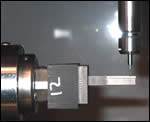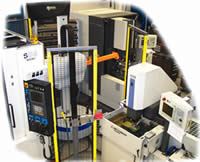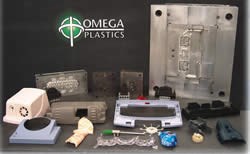Automation Increases Throughput
The addition of an automated cell helps moldmaker/prototyper increase efficiency and speed.
Omega Plastics (Clinton Township, MI)—a provider of high-quality tooling and low-volume molding solutions—takes pride in offering its customers a variety of tooling solutions, including prototyping, in industries like medical, automotive and consumer packaging. In order to decrease leadtimes and maintain a profit, the company decided the time was right to investigate the possibility of automating the 75-person, 70,000-square foot shop.
According to Omega Plastics President/CEO Jeff Kaczperski, today's increased competition in the industry forces moldmakers to be "extremely aggressive" if they want to keep their doors open—and this competition is a key reason for the company's decision to automate.
Mike Pavlica, VP of operations and finances, elaborates. "We produce more than 400 tools a year, and excel at providing moderate complexity molds fast. In the past, customer quality requirements used to be much less stringent for prototype molds. Now that has changed and customers are looking for production-quality parts from class 103-105 molds. Whether they require an aluminum prototype mold or a P20 steel tool, we can provide it. Our customers come to us to not just for their low volume parts, but many come for our APQP, engineering, program management support and understanding of what it takes to help make them successful in production. We've recently been offering bridge tooling as well—providing our customers a big advantage in getting to market faster with production quality parts from our molds while they wait on their high-volume source to finish their high-cavitation 101 molds.
"To reach our vision of seeing low-volume plastic products launched into production faster, with better quality, and with a lower overall cost than they ever have before requires continual improvement, knowing your customer, and a very significant investment in the latest technology, training, people and processes," Pavlica continues. "So where do you begin? For Omega, we've always been a market leader in speed and we wanted to maintain that edge while increasing equipment utilization and effectiveness. We learned it can't be done or economically justified by just adding more moldmakers. Since caring about the well-being of our associates is one of our core principles, we didn't want to do it through eliminating moldmakers either. What we needed were processes and the right equipment to get more work through the system. When we evaluated our entire process, we chose automation as the best option for us to meet our customers' speed and cost objectives."
The Answer Is Automation
After conducting extensive research and by visiting a number of EDM equipment manufacturers, Omega Plastics decided to go with the newly designed and introduced Mitsubishi model EA12V and System 3R WorkMaster Robot in an automated cell to address its challenges. The company worked closely with MC Machinery Systems (Wood Dale, IL)—who was the first company to introduce automation in the company's thought process. Omega Plastics was impressed by their role more as "project consultants" than "salespeople"—and determined this was the best fit for their business.
"Initially we approached suppliers for a quote on a new sinker EDM and two new automatic tool changers," CNC manager Louis Wilson recalls. "Together, we strategized and purchased the WorkMaster Robot simply for changing out the electrodes from our two sinkers, our existing Mitsubishi EA8, and our new EA12V. Then, we started by standardizing and automating different parts of our mold building process to increase our efficiencies. Electrode holders were standardized as much as possible to incorporate a similar design for commonality.
"Then, once we purchased the equipment we applied some of our own unique manufacturing processes," Wilson continues. "We set up a customized mold build tracking system—and combined with the automatic cell—our throughput really began to improve. There are components of the cell that are common to all systems (the robot, fixtures, etc.), but the real trick is to try and get them all to ‘communicate' when you've got the robot talking to both of your sinker EDMs. It also is challenging to get everything set just right so you can achieve the best in unattended productivity. The keys to success are the right equipment, the right people and the right processes. You have to have all three; it's not simply about buying the equipment. We're fortunate to have a very flexible and highly talented team, and we really challenged each other to find the very best solutions, not just any solution."
In time, as the company's processes are evolving, they are adapting the robot to change out workpieces from their EA12V, and are working to do the same with their Makino S-56. "As more time passes, we'll be incorporating a high-speed graphite mill into the cell. MC Machinery provided us with a solutions-oriented plan that evolved into what we are doing today," Wilson notes. "We are the very first company in North America to invest in this newly designed EA12V."
Wilson adds that while the equipment manufacturers and suppliers can be extremely helpful in teaching about what the equipment can do, he found Omega employees needed to do a lot of homework, research and experimentation on their own. "Each company is unique in the way they go about designing and building molds, so you really have to find your own way to a certain extent. You need to spend a lot of time and resources to make the equipment function in your specific application. It's important to analyze your own business and how you want to apply the equipment to your own business—and how it fits within your strategy."
Change Is Good
While the company has embraced the many advantages the automated cell provides—increased throughput, the ability to take on more work and faster timing—they acknowledge that the changes have led to some challenges. "There is so much on the process side you have to work through," Wilson notes. "It does change your system. Our applications programmer gathered input from our tooling leaders on best moldmaking practices and developed some custom software to allow us to analyze the components of our business and track things more effectively. All in all, this has been a great team effort, and everyone had input into what would create the biggest bang for the buck and help improve their throughput personally as well as for the company. We never lost sight of the fact that our focus can't be on just building a tool, but is all about getting the customer into production as effectively as possible."
"We've had excellent support from Mitsubishi EDM and great people internally to work through issues," Kaczperski adds. "We've been able to work through tremendous change with no negative impact on our customers. Your people need to be up for the challenges that come with such a change and be willing to accept change."
Omega Plastics sales manager Chris Buch looks at the automation addition from a sales perspective. "We've seen the quality of the tools go up, which is hard to quantify other than to say that customer satisfaction has been excellent. And—as an end result of that customer satisfaction—we've experienced increased quote volumes and overall higher sales volumes."
Overall, Omega Plastics is very satisfied with the investment they made. "We started this process more than a year ago and began a very aggressive implementation timeline of three months, but the reality of it is takes about six to nine months before you begin to get proficient," Kaczperski notes. "Over the past couple of months we are beginning to see tremendous advantages. You can get the cell up and operating in weeks, but to really understand all of the nuances and get it incorporated into your processes takes much longer.
"We know that automation is the path we've chosen," Kaczperski continues. "As our sales and productivity increase, we will continue to drive automation—however that looks—whether it is new equipment or new processes. It's a path that we will continue to go down. There are no short-term plans to purchase additional robots until we've analyzed how productive we really can be, but as we continue to grow, we'll do whatever it takes to be an automated shop competitive in today's environment. It's really been a nice win for us."
Related Content
Maintaining a Wire EDM Machine
To achieve the ultimate capability and level of productivity from your wire EDM on a consistent, repeatable and reliable basis, regular maintenance is a required task.
Read MorePrecision Meets Innovation at IMTS 2024
After attending IMTS, it's clear that the integration of advanced technologies is ready to enhance precision, efficiency and automation in mold manufacturing processes. It’s a massive event, so here’s a glimpse of what the MMT team experienced firsthand.
Read MoreMMT's Most-Viewed Case Studies in 2024
Did you miss any of MoldMaking Technology’s most-viewed case studies from 2024? Now’s your chance to dive into these trending topics.
Read MoreQuality Tool & Die Enhances Performance With Advanced EDM and Milling Technologies
The adoption of Mitsubishi wire and sinker EDMs, along with the OPS Ingersoll five-axis milling machine with automated cells, has enabled unmanned operations and improved precision. As a result, QTD has expanded its facility, grown its workforce and increased its business by 10-15% annually.
Read MoreRead Next
EDM Additions Equal Productivity and Profitability
EDM Additions Equal Productivity and Profitability
Read MoreHow to Use Continuing Education to Remain Competitive in Moldmaking
Continued training helps moldmakers make tooling decisions and properly use the latest cutting tool to efficiently machine high-quality molds.
Read MoreReasons to Use Fiber Lasers for Mold Cleaning
Fiber lasers offer a simplicity, speed, control and portability, minimizing mold cleaning risks.
Read More
























